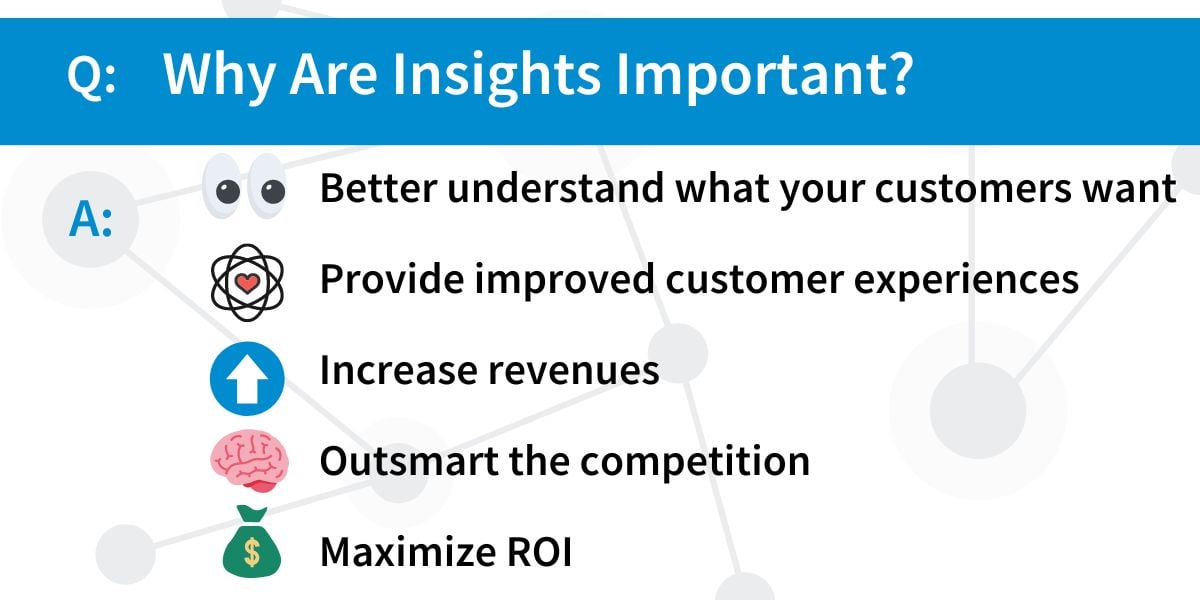What Is an Insight in Marketing?
April 8, 2020 •DJ Team

Whenever you create a marketing campaign, it’s important to track how well it does. Doing so will allow you to more successfully develop future campaigns based on what you observe. How do you track the success of these campaigns, though? Through insights.
Keep reading to learn more about what insights are, why they’re important, and how to get them.
What Is Insight?
In business, insight is the combination of life/work experiences with systematically-collected and analyzing data. Data without added business context isn’t valuable because it doesn’t show you what you should do next.
Marketing insights meaning is therefore the process of developing a deep understanding of consumers, customers, competitors, and the industry in general.
(Get free consumer insights on your target audience here.)

Why Are Insights Important?
If a business gets one bad review, it's easy to write it off as just an opinion, even though you work to make it right when you can. But if 100 people say something similar, you have something you need to address on a larger scale. This data shows that you need to rethink the systems that led to those bad experiences, but insights you can glean from these 100 bad reviews are what will make the biggest impact on your business’s success tomorrow.
The benefits of marketing insights are that they help you:
- Better understand what your customers want
- Provide improved, and more personalized, customer experiences
- Increase revenues because you can better influence over response rates, when people buy, average order value (AOV), and reorders
- Outsmart the competition, rather than just outspend them
- Maximize ROI because insights direct business actions that cut costs and improve results at the same time. Optimization.

How to Get Insights
The Importance of marketing insights is evident. But how do businesses gain these marketing insights? Today, the average person leaves a massive digital footprint. So, the way to gain insights is by following and analyzing those footprints.
We accomplish this with analytics tools that:
- Collect data from across online channels (social media, your website, your competitors' websites with competitor analysis tools, etc.)
- Organize and analyze that data. This is big data, so these tools must be able to work with vast amounts of data that no room full of analysts could process alone.
- Present that data in a useable form
That last one is essential. A Gartner study found that 87% of businesses have a low BI (Business Intelligence) accompanied by an immature sense of how to use analytics to fuel growth and meet business goals.
That may sound like an insult. But it's one every business leader should consider. If we don't know how to use all the data we collect, what use is it?
Advanced consumer insight tools solve this problem by delivering not just data, but real insights you can use now and almost immediately see the benefits. You still need an insights team to evaluate those insights and decide how to implement strategies. But these insights help you make the data-driven decisions you need to do so.
One common method marketers often use to glean insights from these analytics tools is by evaluating their marketing attribution reports. Marketing attribution is helpful because of its ability to retroactively analyze all the marketing touches that led to your sales and offer insight into what touchpoints mattered most, and where they sit in your marketing funnel.
How to Write an Insight Statement
Oftentimes, it’s beneficial to put into writing the information you’re gathering from the data at your disposal.
This statement should describe the current scenario consumers are facing, highlight their current frustrations, and based on these, illustrate an ideal future state they are looking for. When you have this insight statement in front of you, it is easier to build your marketing campaigns around helping the consumer see themselves in that idealized future state.
Examples of Insights
You can arrive at brand insights by looking at:
- How customers respond to your marketing messages and content
- Which paths customers take
- Whether customers buy
- Whether customers leave for a competitor
- Where customers come from
- Your reach in comparison to the competition
Examples of insights like these are achieved through marketing analytics tools that deliver helpful market insights reports.
How Do You Get Marketing Insight? Use DemandJump
The consumer insights industry is saturated with tools that provide these kinds of insights. But merely tracking what happens on your website or treating social media data as separate from your AdWords data won't give you the whole picture. You need to get the whole story and see the entire customer journey across channels in one place.
To start getting the whole picture for your business, use DemandJump. We offer reports that show you what your target audience is searching for related to whatever topic you choose. Our reports also include information on how much traffic you and your competitors get for each of those searches. We will provide you with a list of keywords and questions to include in your content to boost your website’s traffic. Create an account for free today and get the insight you need for your business to succeed!
Featured Articles
Categories
- Attribution Tracking (13)
- Channel Optimization (11)
- Consumer Insights (68)
- Content Marketing (251)
- Data Science (8)
- Digital Marketing (6)
- Digital Transformation (26)
- Enterprise (10)
- Lead Generation (14)
- Market Intelligence (8)
- Marketing Analytics (39)
- Marketing Attribution (57)
- Marketing Management (153)
- Marketing Operations (86)
- Organic Search (222)
- Paid Search (52)
- Pillar-Based Marketing (63)
- Programmatic Advertising (9)
- SaaS Content (14)
- SaaS Marketing (29)
- Search Marketing (111)
- SEO Keyword Research (28)
- SEO Pillar (18)
- SEO Strategy (46)
- SMB (5)
- Website Content (12)


